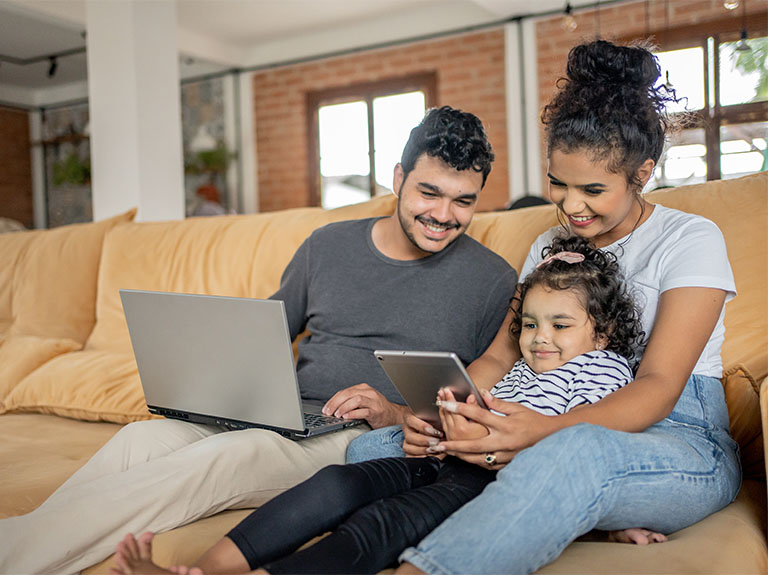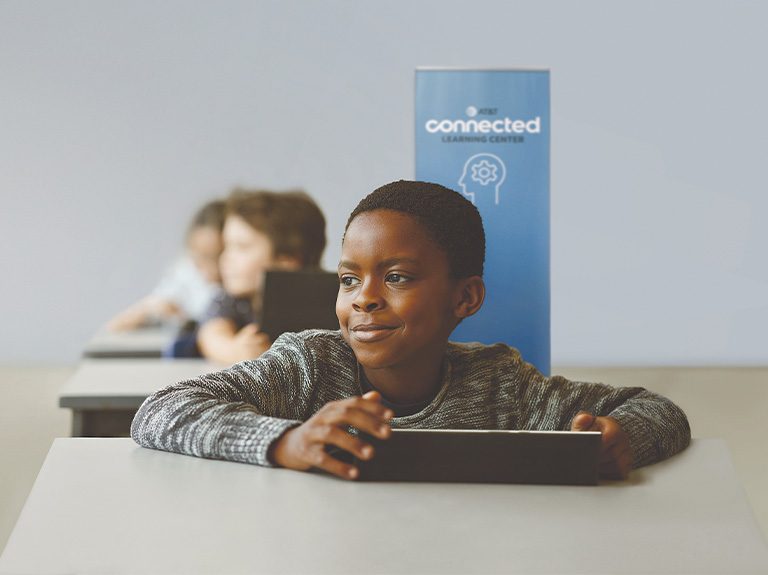Español
Download release (PDF)
AT&T Makes $2 Billion, 3-Year Commitment to Help Bridge the Digital Divide
Through low-cost broadband offers, participation in the Emergency Broadband Benefit (EBB), and community investment – AT&T to bring robust broadband connectivity to more Americans
What’s the news?
Today, AT&T announced it will invest $2 billion over the next 3 years to help address the digital divide.
This renewed commitment to the communities we serve combines AT&T’s low-cost broadband service offerings with community investment. And it builds on the company’s contribution of $1 billion over the last 3 years toward helping the nation’s most vulnerable communities.
We’re dedicated to doing our part to bring affordability, educational resources, and economic opportunity to the millions of Americans who don’t have broadband connectivity today.
“We believe that broadband connectivity is essential for all Americans,” said John Stankey, CEO, AT&T. “Our broadband networks rose to the challenge of the pandemic in part due to policies that promoted private sector investment in multiple technologies and networks. AT&T is investing in and expanding the reach of our broadband networks while also advocating for effective and sustainable public policies that help close this country’s digital divide.”
How will we do this?
Expanding affordable broadband through AT&T’s low-cost offers and the Emergency Broadband Benefit program administered by the FCC
- Education Offers: We continue to offer discounted wireless solutions to more than 135,000 public and private K-12 schools, colleges, and universities. These offers help keep students and teachers connected in a 1:1 learning model to assist in transforming education beyond when schools reopen. High-speed internet should enable new learning opportunities, not be the barrier to them. That’s why we’ve stepped up our support over the last year to address education inequality for the almost 17 million students, predominately children of color in low-income and rural households, who don’t have internet connectivity.
- Access from AT&T: Introduced 5 years ago, this AT&T-funded program makes the internet more affordable for customers by providing qualifying households with wireline internet service at $10 or less per month. This voluntary offer from AT&T has no contract or installation fee. Plus, it includes in-home Wi-Fi at no additional cost. We are continuing to waive data overages for these customers, and we’re keeping the expanded eligibility to qualifying households and those participating in the National School Lunch Program and Head Start. Hundreds of thousands of Americans enjoy Access from AT&T, and we aim to build upon this voluntary program, partnering with government policymakers to ensure sustainable funding to keep broadband options affordable for qualifying households.
- Emergency Broadband Benefit (EBB): In another move to make the internet more affordable for more people, eligible customers will be able to temporarily reduce their monthly broadband costs by taking advantage of the Federal Emergency Broadband Benefit (EBB). This government program administered by the FCC will allow more than 30 million eligible1 households to receive an additional subsidy of up to $50 a month. Those on Tribal lands are eligible for up to $75 per month. The monthly cost of broadband – after applying the Emergency Broadband Benefit – can fall to as low as $0 a month.2
The EBB can be applied to eligible home internet services like Access from AT&T or AT&T Internet, available within our 21-state wireline footprint. Or it can be applied toward eligible postpaid or prepaid wireless plans at AT&T, AT&T PREPAID and Cricket Wireless, which are available in all 50 states.
Once customers verify that they are eligible, we’ll apply the benefit to their service until the EBB ends. The uniform program start date is pending an FCC announcement.
“We tip our hat to Acting FCC ChairwomanJessica Rosenworcel for her leadership in making the Emergency Broadband Benefit available to more than 30 million households,” Stankey said. “The EBB is a great first step in addressing affordability in the short term. We continue to encourage Congress to work on more permanent solutions with sustainable funding so that all Americans can have access to affordable broadband.”
Last week, AT&T joined nearly 50 advocacy organizations, companies, and non-profit groups setting out the guiding principles for Congress and the Biden Administration as it debates the specifics for the American Jobs Plan. We urged policy makers to enact sustainable, effective broadband policies that have proven to build the most resilient broadband networks, create jobs and empower opportunities for all Americans.
“The COVID-19 pandemic has laid bare the broadband challenges we have been fighting to resolve for years,” said Marc Morial, President & CEO, National Urban League. “We applaud AT&T’s recent efforts to ensure that all people – and especially historically unserved and underserved communities — can access affordable, reliable broadband internet.”
Will Townsend, senior analyst with Moor Insights & Strategy, added: “The digital divide in America is real and the challenges are being magnified during the pandemic. Many have to scramble to find Wi-Fi hotspots to support critical activities such as telemedicine sessions and distance learning. I applaud AT&T's efforts to bridge the connectivity gap with incremental investments and subscriber subsidies, as well as no-cost educational content through its WarnerMedia division.”
Linda Ng, National President, OCA-Asian Pacific American Advocates, said:
“As we work to remedy existing gaps in internet access and overcome the challenges associated with connecting every single American to broadband service, we celebrate the efforts of AT&T and others working hard to help close the digital divide. This kind of sustained industry engagement will be indispensable for getting families, students, educators, and others in communities with the most urgent need online.”
Introducing AT&T Connected Learning
According to a recent Morning Consult survey, more than 70% of parents and teachers think the traditional classroom learning environment will rely more heavily on technology after the pandemic. Additionally, 80% say their kids would be more interested in learning tools that include popular entertainment.
AT&T Connected Learning is our multi-year commitment to help stem the tide of learning loss, narrow the homework gap, and create compelling educational content. The initiative builds on our previous investments and long-standing commitment to education. It includes multiple solutions to connect today’s learners with the skills, resources, and opportunities for success in school and in life.
Together with WarnerMedia, we’re developing a digital learning platform that will deliver high quality educational content and curriculum everywhere today’s connected students learn – in the classroom, at home, and in the community. This digital resource will provide:
- Exclusive educational content from WarnerMedia properties and talent.
- Learning tools from leading education groups to help students and families navigate distance learning and improve academic success. The platform will also provide resources to support socio-emotional learning and critical thinking skills.
In collaboration with our employees and local organizations, we’re launching 20 AT&T Connected Learning Centers in 2021. These Connected Learning Centers will be in traditionally underserved neighborhoods where residents face barriers to connectivity.
- To facilitate digital learning at the centers, we’ll provide high-speed AT&T Fiber internet, Wi-Fi and ensure the centers have the resources for devices like laptops and tablets. In addition, the centers will have access to WarnerMedia content. We’ll also provide access to virtual learning tools from collaborators like Khan Academy.
- Students will have opportunities to be mentored and tutored through our employee-driven AT&T Believes volunteerism initiative. The resources that will be available at the centers will allow students to complete assignments and access digital learning tools content with ease. These centers will help reach more students from historically under-resourced communities and provide them with the access, tools, and mentoring they need to succeed.
Together with Public Library Association (PLA), a division of the American Library Association, we will offer a specially curated collection of digital literacy courses to help parents and families build the skills and confidence they need to help their child navigate distance learning and participate effectively and safely in today’s digital world. Courses will be available virtually for everyone and offered in-person at our Connected Learning Centers and public libraries and as part of PLA’s nationwide digital literacy initiative.
1 Eligibility determined by the National Lifeline Eligiblity Verifier (National Verifier), managed by the Universal Service Administrative Company (USAC). For more information on eligibility criteria for the EBB visit getemergencybroadband.org.
2 Additional fees and taxes may apply.



